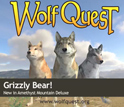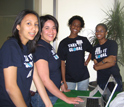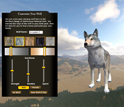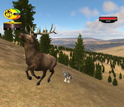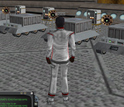

Press Release 08-147
Real-World Lessons in Virtual World

Designing and playing computer games can engage students in science and mathematics
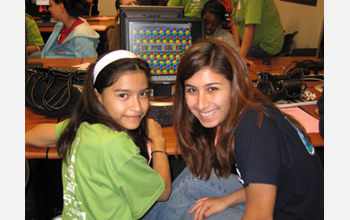
A high-school student demonstrates a game she developed, soliciting feedback from a middleschooler.
Credit and Larger Version |
August 27, 2008
View a video of WolfQuest, an interactive computer game in which players are immersed in every aspect of a wolf's survival in its habitat.
It's bad enough that I haven't found a mate. I'm also hungry and I'm losing stamina. I've lost the rest of my group and a large grizzly bear has positioned himself across my path. What's a wolf to do? Adopting the identity of a wolf is the key to learning about wolf behavior and ecology in WolfQuest, a computer game developed and hosted by the Minnesota Zoo with funding from the National Science Foundation. WolfQuest is one example of how, through computer gaming technology, learning can reach across time and space and link learners to a set of challenges--along with a set of tools to address them, and the motivation to succeed. Other such projects developed with NSF funding include "Project IT Girl," a project that involves high-school girls in designing and developing educational games, and LunarQuest, a multiple-player game that aims to support the learning of physics. Through computer games, a single player can immerse himself or herself in a problem that demands the tools of science or math to solve it. The technology can also link a team of players who must work together and pool their resources to address issues. Just as the technology provides a network for learning, it also provides a trail of results detailing the players' success in rising to the challenges presented. The central premise in WolfQuest is that immersion in the game motivates players to learn about how wolves survive, thereby absorbing a series of lessons about the animals' biology and their interactions with other wolves, prey and their environment. Players create a wolf avatar by developing an online identity that includes the age, sex and markings desired by the player. Players can use controls on their computer keyboards to move wolves through their habitat, running, jumping, catching prey and communicating with other wolves as prompted by a dynamic environment on their computer screens. A videocapture from the game (play video at right) shows just one example of the kind of challenge a player might face: what to do when a grizzly bear zeroes in on a wolf's fresh kill. Since its launch in December of 2007, the game has been downloaded from the WolfQuest site at http://www.wolfquest.org/ more than 200,000 times. The game also supports an online community of players from all over the world who share each other's passion for wolves and have an online venue for taking part in activities such as a wildlife photography contest. "WolfQuest allows players to learn by doing," says Grant Spickelmier, assistant director for education at the Minnesota Zoo and co-principal investigator for this project. "The game portrays every aspect of a wolf's life." In developing WolfQuest, Spickelmier and his team had all its elements reviewed by wolf biologists to ensure that the game accurately represented wolves in their natural habitat. Instead of offering facts about wolves, the game encourages a trial-and-error approach to determine what strategies are most helpful to a wolf's survival. Players quickly start to figure out that wolves generally can't outrun a healthy elk and that their wolf's survival depends on their monitoring the wolf's health and stamina. These factors are tracked in meters attached to each of the avatars. Eating replenishes health, while hunting without success diminishes it. As stamina fades, so does the strength of the wolf's bite, making it harder to kill its prey. So, as they play the game, players start to understand why wolves hunt in packs as a survival strategy. The game play not only illuminates ecological principles, including predator-prey relationships; it also develops problem-solving skills where learners must review, analyze and reflect upon the consequences of their actions in the game-based scenarios, and predict what will happen to wolves as a result of their next actions. With its unique learning strategies, WolfQuest will aggregate data on participants' engagement in the game, including science content gained and attitudinal changes among players. Ultimately these results will guide the development of future science education games, along with appropriate methodologies for evaluating game-based learning. Currently, an online community forum attached to the game has 15,000 members who have made more than 300,000 posts so far. Many of the posts are from the WolfQuest target audience--kids 10-15 years old. The players often teach each other and exchange information about wolves, with the help of wolf experts who monitor the site and come online to offer information and assistance. (Advisors to the project include L. David Mech and Dan MacNulty, two of the top wolf biologists in the world.) The current version of the game is the first of two planned levels, with the next one giving players the opportunity to establish a den with their mates and raise a litter of pups. A larger goal of the game is to see if it can encourage young people to get out into the natural world. "Our hope is that, because we're portraying wolves in Yellowstone National Park in an accurate way, that it will encourage kids to want to see the park in real life," says Spickelmier. The site also offers resources in players' geographic areas, including zoos that have wolf exhibits. Spickelmier notes that although he's at the Minnesota Zoo, only one percent of the WolfQuest players are from Minnesota. Forty-four percent are from outside the U.S., with a large portion from India and Germany. Having an international reach is also one of the goals of "Project IT Girl," which involves girls in the design and development of computer games. With a dearth of girls and women involved in computer sciences (NSF's latest statistics show almost three times the number of men as women majoring in computer science), IT Girl presents an opportunity for high-school girls to design, program and test games targeted for middleschoolers. In the process, the project aims to build the girls' competency and interest in science, technology, engineering and math (STEM) careers. "This is not just programming for programming's sake," says project director Zakiyyah Kareem. "This is using technology to help connect the student to the larger world." IT Girl is a three-year project that involves 60 girls beginning in their sophomore year of high school. The project--developed by Girlstart, a non-profit organization created to empower girls to excel in math, science and technology--targets minority and economically disadvantaged girls from multiple school districts in the Austin, Texas, area. In the first year of the project, the girls identified global challenges that interested and concerned them, and had an opportunity to learn about and practice the research process, including interviewing experts in the field from the worlds of academia, government and industry. In a summer session, the girls went through an intensive digital media and filming curriculum to create public service announcements to educate their peers about global issues such as AIDS/HIV awareness, "green" energy choices and smart growth. In the second year, the girls conceived, wrote, designed, programmed and produced their own games using the Python programming language and entirely open source and non-copyrighted materials. The girls' work included creating a storyboard of their game designs, creating custom game graphics, creating a poster about their game and giving demonstrations/presentations and customer pitches about the games. The games were showcased in the community and submitted to the One Laptop per Child project for possible distribution to schools around the world. Games and PSAs are accessible at the project Web site at http://www.girlstart.org/itgirl/. Over the summer, students brought their skills to the online virtual world, Second Life, learning how to create an event that would draw students from all over. They sampled games, blogged about their experiences, and created exhibits. In the third year of the program, which begins after Labor Day, IT Girl recipients will learn critical leadership skills, serve their community and prepare for college, all while completing technology-based projects. There will be lessons about their online image in social networks such as Facebook. "These girls have only known this world of connectivity and the Internet," says Kareem. In their final year, they will learn how to use the online world to articulate the work they have done over the past two years, including how to develop online portfolios. Older students in entry-level college classes will learn physics in a new way through the online game, LunarQuest, a multiplayer online game where players can undertake a series of tasks, compete and advance in the world of the game. The premise of LunarQuest--a project at the University of Central Florida--is that humans are colonizing the moon. Towards that end, operations need to run smoothly in buildings under a giant dome, and exploration and the production of food need to advance as well. Inserted into the retro-science fiction look of the game are mini-games that carry lessons in physics. For example, the robots that deliver the mail to lunar colonists are frequently lost, so players have to apply the principles of vectors to program the robots to get to the proper locations. In another mini-game, projectiles need to be shot out of a cannon from a fixed location in a parabolic curve, so students get practice in applying the appropriate level of force to create such a curve. As they progress through the game, students complete tasks to earn points and obtain privileges, such as getting a space suit and gravity boots--these allow players to leave the domed city and do additional exploration. "While videogames have been used in education and training, there hasn't been a lot of learning science around them," says principal investigator Jan Cannon-Bowers. "With LunarQuest, we're looking at whether we can build games consistent with learning science." According to Cannon-Bowers, massive-player games like this offer both motivational and immersive aspects to promote learning. This fall, she and her team are getting ready to do their first study on LunarQuest with students in the physics department at Penn State. They will have three groups of physics students participate in the game--non-science majors, science majors not majoring in physics and physics majors--and will measure the impact of LunarQuest in how well students perform in physics. Cannon-Bowers hopes to bring the game to a wider audience beginning in 2009. If the game is successful, other mini-games could be inserted to support learning in other scientific disciplines and in younger students. "Our goal is to help kids be engaged in science," says Cannon-Bowers. "If this can help motivate them and help them apply what they'd learned, it can support what's going on in the classroom." More information about LunarQuest is accessible at http://seriousgamesresearch.com/. -NSF-

Media Contacts
Maria C. Zacharias, NSF (703) 292-8070 mzachari@nsf.gov
Program Contacts
Arlene M. de Strulle, NSF (703) 292-5117 adestrul@nsf.gov

The National Science Foundation (NSF) is an independent federal agency that supports fundamental research and education across all fields of science and engineering, with an annual budget of $6.06 billion. NSF funds reach all 50 states through grants to over 1,900 universities and institutions. Each year, NSF receives about 45,000 competitive requests for funding, and makes over 11,500 new funding awards. NSF also awards over $400 million in professional and service contracts yearly.
 Get News Updates by Email Get News Updates by Email
Useful NSF Web Sites:
NSF Home Page: http://www.nsf.gov
NSF News: http://www.nsf.gov/news/
For the News Media: http://www.nsf.gov/news/newsroom.jsp
Science and Engineering Statistics: http://www.nsf.gov/statistics/
Awards Searches: http://www.nsf.gov/awardsearch/
|



